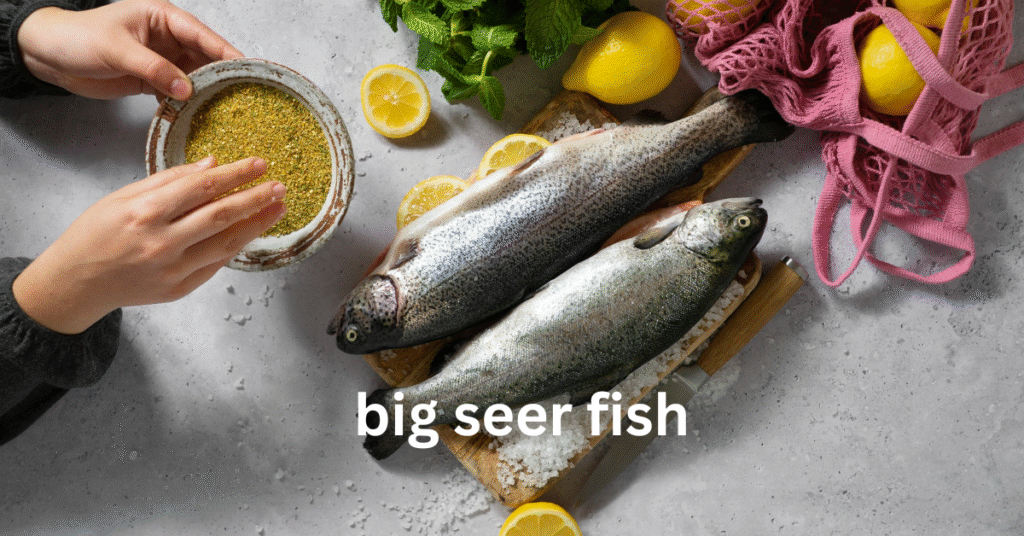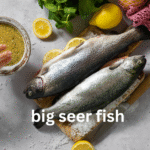The big seer fish’s, known scientifically as Scomberomorus commerson, is one of the most prized fish’s species across Asia, the Middle East, and Africa. Searchers often want to know about its size, nutritional value, market demand, culinary uses, and sustainability. In simple terms: this is not just a fish; it is a symbol of abundance in coastal households, a highlight in fine dining menus, and a cornerstone of local fisheries economies.
This guide provides a complete overview of big seer fish’s, from its biology and distribution to its nutritional composition, cooking traditions, and global market relevance. It also highlights important aspects such as conservation practices and consumer awareness. By the end, readers will have a thorough understanding of why big seer fish’s is celebrated across cultures and oceans.
Overview of the Big Seer Fish
The big seer fish belongs to the mackerel family and is one of the fastest swimmers in tropical waters. It is distinguished by its elongated body, sharp teeth, and striking silver scales. Often exceeding a meter in length, it is both a predator in the marine food chain and a valuable food source for humans.
Its popularity is not new. Historical records suggest that coastal communities in India, Sri Lanka, and the Persian Gulf have relied on seer fish’s for centuries. Known locally as “King Fish” in some regions, it has developed a reputation not just for its taste but also for its ability to provide vital nutrition.
Biological Characteristics
To understand the significance of the big seer fish’s, one must begin with its biology.
- Scientific Name: Scomberomorus commerson
- Family: Scombridae (mackerel family)
- Average Length: 80–150 cm
- Average Weight: 10–25 kg, though some grow larger than 40 kg
- Lifespan: 12–15 years
- Habitat: Coastal waters, often in tropical and subtropical seas
Its streamlined body allows it to swim at remarkable speeds, making it a favorite among sport fishers as well. Unlike smaller pelagic fish, big seer fish are solitary hunters, feeding mainly on sardines, anchovies, and small crustaceans.
Table: Key Facts About Big Seer Fish
| Feature | Description |
|---|---|
| Common Names | Seer Fish, King Fish, Spanish Mackerel |
| Scientific Name | Scomberomorus commerson |
| Average Size | 80–150 cm length, 10–25 kg weight |
| Habitat | Coastal tropical and subtropical waters |
| Diet | Sardines, anchovies, crustaceans, smaller fish |
| Nutritional Value | High in protein, omega-3 fatty acids, vitamins B12, D, and essential minerals |
| Culinary Popularity | Widely used in Asian, Middle Eastern, and African cuisines |
| Market Demand | Very high in both domestic and export markets |
| Conservation Status | Not endangered, but faces overfishing pressure |
Nutritional Value
Big seer fish is renowned for its nutritional richness. Its flesh is firm, white, and low in bones, making it easy to prepare and highly appealing for families.
Nutritional Highlights per 100 grams (approximate values):
- Calories: 108
- Protein: 21 g
- Fat: 3 g
- Omega-3 fatty acids: 0.7 g
- Vitamin B12: 4 mcg (over 100% of daily requirement)
- Vitamin D: 400 IU
- Minerals: Selenium, magnesium, potassium, phosphorus
The high protein content supports muscle growth and repair, while omega-3 fatty acids contribute to cardiovascular health. Regular consumption is often recommended in diets aiming to lower cholesterol, improve brain function, and support overall wellness.
Culinary Importance
The big seer fish enjoys immense popularity in kitchens worldwide. Its flesh is lean yet flavorful, adaptable to grilling, frying, baking, or steaming.
Regional Cuisines:
- South Asia: In India and Sri Lanka, seer fish curry is a delicacy. Spiced with turmeric, chili, and coconut milk, it balances bold flavors with tender meat.
- Middle East: Grilled seer fish with saffron and lemon is common in Persian Gulf households.
- Africa: In East African coasts, the fish is marinated in garlic and herbs before being grilled over charcoal.
- Western Influence: Seer fish fillets are often pan-seared in olive oil with herbs, making it a fine dining choice.
Because of its size, a single fish can provide multiple cuts suitable for steaks, fillets, or soups. Its versatility makes it an essential staple in both local markets and luxury restaurants.
Fishing Practices
Fishing for big seer fish is both a livelihood and a sport. Traditional fishers often use nets and hooks, while commercial operations rely on larger trawlers. Sport fishing communities admire the seer fish for its strength and speed, often considering it a prized catch.
However, increased demand has put pressure on natural stocks. The challenge lies in balancing consumer needs with sustainable practices. Overfishing, particularly during breeding seasons, has led to concerns about long-term availability.
Market Value and Trade
The big seer fish commands high prices in both local and international markets.
- Domestic Demand: Families in coastal regions often purchase it fresh from local fishermen. Prices vary depending on size, freshness, and season.
- Export Demand: Gulf countries import large quantities of seer fish from South Asia.
- Restaurant Trade: Its reputation as “King Fish” ensures it remains a premium option in fine dining menus.
In many markets, seer fish is sold whole, in steaks, or as frozen fillets. Its high protein value and low bone structure make it particularly appealing to urban consumers who prefer quick cooking options.
Health Benefits
Regular consumption of big seer fish provides multiple health benefits:
- Cardiovascular Health: Omega-3 fatty acids reduce the risk of heart disease.
- Brain Function: DHA content supports memory and cognitive performance.
- Bone Strength: Vitamin D and phosphorus aid bone health.
- Immunity Boost: Selenium enhances immune response.
- Low-Calorie Protein Source: Ideal for weight-conscious diets.
Doctors often recommend fish like seer as part of a balanced diet for individuals managing hypertension, diabetes, or high cholesterol.
Sustainability and Conservation
The increasing popularity of seer fish has sparked discussions on sustainability. Overfishing, particularly of juvenile fish, threatens future stocks. Coastal communities have begun to adopt better practices, such as:
- Seasonal bans during spawning months
- Minimum size regulations
- Promotion of aquaculture alternatives
Consumers also play a role by choosing responsibly sourced fish. Labels indicating sustainable fishing practices are increasingly visible in export markets.
Cultural Symbolism
Beyond nutrition and economy, the seer fish carries cultural symbolism. In many coastal weddings, serving seer fish is considered a sign of prosperity. Fishermen often see a big catch as a blessing, while households associate the fish with feasts and festivals.
This cultural relevance explains why demand remains high even during economic downturns. It is more than just food—it is part of identity.
Challenges Facing the Seer Fish Industry
- Overfishing: Declining stocks in some regions due to unregulated catches.
- Climate Change: Warming seas affect distribution patterns.
- Market Pressures: Rising demand increases illegal fishing practices.
- Storage and Transport: Maintaining freshness requires improved cold-chain infrastructure.
- Aquaculture Limits: While farming options are being explored, success is limited compared to smaller fish species.
Addressing these challenges requires cooperation between governments, local fishers, and international bodies.
Consumer Awareness
For consumers, knowing how to identify fresh seer fish is crucial:
- Eyes: Should be bright, not cloudy
- Gills: Bright red, indicating freshness
- Flesh: Firm to touch, no strong odor
- Scales: Shiny and intact
Proper storage at home involves refrigeration within hours of purchase and consumption within two days for best results.
Future Outlook
The future of big seer fish lies at the intersection of demand, conservation, and innovation. With growing health awareness, its role in global diets will expand. At the same time, sustainability measures will define whether future generations enjoy it as abundantly as today.
Aquaculture, consumer responsibility, and regulatory enforcement will be key. If managed well, the seer fish industry can continue to thrive without compromising ocean health.
FAQs
1. Why is big seer fish called “King Fish”?
Because of its large size, rich taste, and culinary prestige, it is popularly referred to as King Fish in many markets.
2. Is big seer fish safe for daily consumption?
Yes, when consumed in moderate portions. Its nutritional benefits make it suitable for regular diets, though balance is important.
3. How can I differentiate seer fish from similar species?
Look for its elongated body, pointed head, and distinctive silver scales without spots. Smaller mackerels often have spots.
4. What is the best cooking method for big seer fish?
It adapts well to grilling, curries, and frying. Its firm texture prevents it from breaking apart during cooking.
5. Is big seer fish endangered?
Not currently, but overfishing poses risks. Choosing sustainably sourced seer fish helps protect future stocks.







